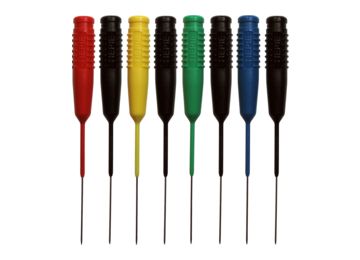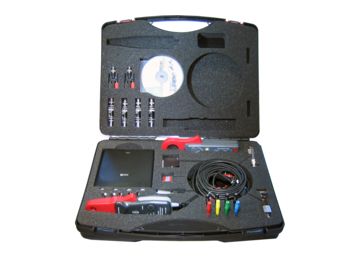Sensor information
| Type: | Hot wire |
|---|---|
| Power supply: | 12 V from system relay and ground |
| Signal type: | Amplitude variating |
| Signal level: | 0.2 V to 4.0 V |
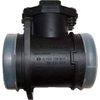
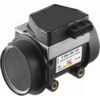
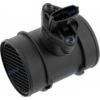
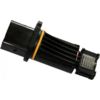
Workings of the hot wire air flow meter
The Mass Air Flow (MAF) sensor measures the amount of passing air going through the air intake system. The sensor measures the amount of passing air with a resistive platinum wire that is placed in the air stream of the air intake system. The resistive wire has a positive temperature coefficient: the higher the temperature the higher the resistance of the wire. Electronics in the air flow meter sends an amount of current through the wire to warm it up. The wire temperature is kept constant. When more air passes the wire, more current is needed to keep the wire at a constant temperature. The current that flows though the wire is a measure for the amount of passing air. The current is measured by the electronics in the sensor and converted to a voltage at the output of the sensor. The engine control unit (ECU) calculates the amount of air going into the combustion chambers from this voltage.
Connecting the lab scope
Correct functioning of the hot wire air flow sensor can be checked by measuring the following signal voltages, see figure 1:
| Channel | Probe | Voltage | Range |
|---|---|---|---|
| 1 |  |
Sensor output signal | 8 V |
 |
Ground on battery | ||
| 2 |  |
Positive side of sensor power supply | 20 V |
 |
Negative side of sensor power supply |
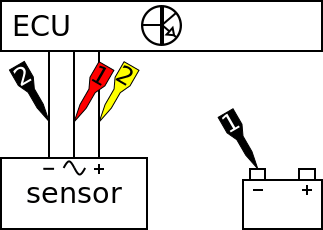
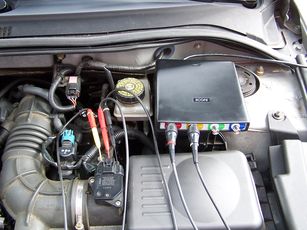
The lab scope is connected to the hot wire air flow sensor via a Measure lead TP-C1812B and Back Probe TP-BP85 and set to recorder mode. In recorder mode a streaming measurement is performed, continuously displaying the signals live on screen. Because the measured signals vary slowly, the Automotive Test Scope ATS5004D is set to a slow measuring speed.
Measuring
Figure 3 shows a waveform of a hot wire air flow sensor of a car with running engine. The signals are measured under the following conditions: key on, cranking, idle, 2000 RPM, 3000 RPM and back to idle. This signal can be downloaded and used to correctly set up the lab scope or as reference signal.
Download hot wire sensor measurement
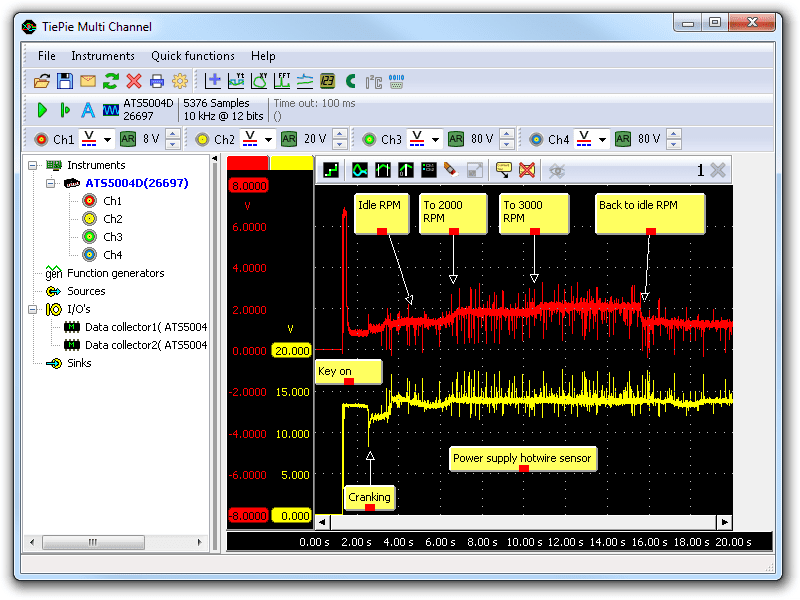
Channel 1 (red) shows the signal of the hot wire air flow sensor and channel 2 (yellow) the power supply of the sensor. At the beginning of the measurement the key is turned on, which is followed by a short pulse in the signal voltage. The short pulse shows the warming up of the wire until it reaches a certain temperature. Shortly after that, the engine is started and some time elapses before the engine speed stabilizes at idle RPM. During the measurement the throttle is opened twice to increase the engine speed and therefore the amount of air passing. With the increase in passing air the signal voltage increases. Nearly at the end of the measurement the throttle is released and the signal voltage drops until the engine speed is at idle again. The power supply has some fluctuation but this has no affect on the performance of the sensor because the electronics in the sensor stabilizes the power supply. The signal from the hot wire air flow sensor shows a low amount of noise and spikes but have no affect on the performance of the engine management system because the ECU filters the input signal voltage.
Diagnosis
Signal values may differ on different types of engine control units and hot wire air flow sensors. Consult ATIS for information on specific engine control units and hot wire air flow sensors.
The following signal deviations can indicate a problem:
-
No signal:
Cause: back probes have no connection (perform a connection test), no power supply, sensor defective -
Signal voltage to high:
Cause: poor or no ground on power supply, sensor defective -
Signal shows more noise than example signal:
Cause: wiring of signal wire or power supply damaged, poor connection in connector terminals, sensor defective -
Signal shows an offset in relation of the example signal:
Cause: scope is not set to DC coupling: ,
poor power supply to air flow meter, false air leaking into the air intake system, sensor defective
,
poor power supply to air flow meter, false air leaking into the air intake system, sensor defective
RELATED PRODUCTS
RELATED ARTICLES
- Manifold Absolute Pressure (MAP) sensor
- With a lab scope a Manifold Absolute Pressure (MAP) sensor is measured under the following conditions: key on, cranking, idle, 2000 RPM, 3000 RPM and back to idle with an engine at operating temperature. The signal from the sensor is shown and can be downloaded. To help determining whether a MAP sensor is functioning correctly, different possible deviations from the example signal are mentioned along with probable causes.
- Mass Air Flow (MAF) vane sensor
- With a lab scope an air flow sensor is measured under the following conditions: key on, cranking, idle, 2000 RPM, 3000 RPM and back to idle with an engine at operating temperature. The signal from the sensor is shown and can be downloaded. To help determining whether an air flow sensor is functioning correctly, different deviations from the example signal are mentioned along with possible causes.
- Troublesome Volvo XC70
- A Volvo XC70 had serious engine related drivability problems. The engine lacked power, would hold back and even stall. Error codes indicated problems in two different areas. Replacing components did not improve things. Proper measuring with an automotive diagnostic oscilloscope revealed two independent problems. Fixing these solved all problems.
This document is subject to changes without notification. All rights reserved.
The information in this application note is carefully checked and is considered to be reliable, however TiePie engineering assumes no responsibility for any inaccuracies.
Safety warning:
- Before measuring, check that sources of dangerously high voltages are switched off or shielded from contact. Voltages considered to be dangerous are voltages over 30 V AC RMS, 42 V AC peak or 60 V DC.
- Keep a clean working environment when doing measurements.
- This measurement and procedures are a examples / measuring suggestions and are no prescribed protocols.
- TiePie engineering can not anticipate the safety actions that need to be taken to protect persons and appliances. Before starting a measurement, check which safety measures need to be applied.


